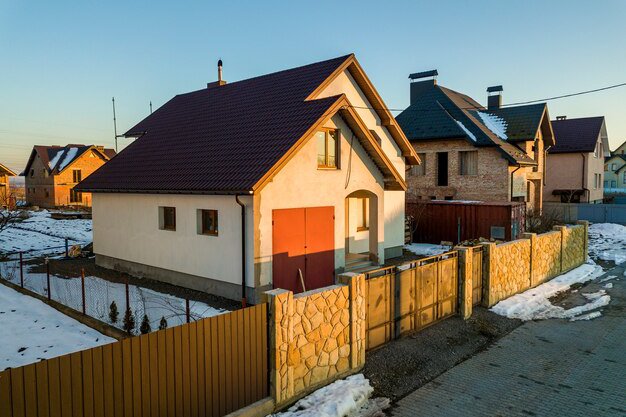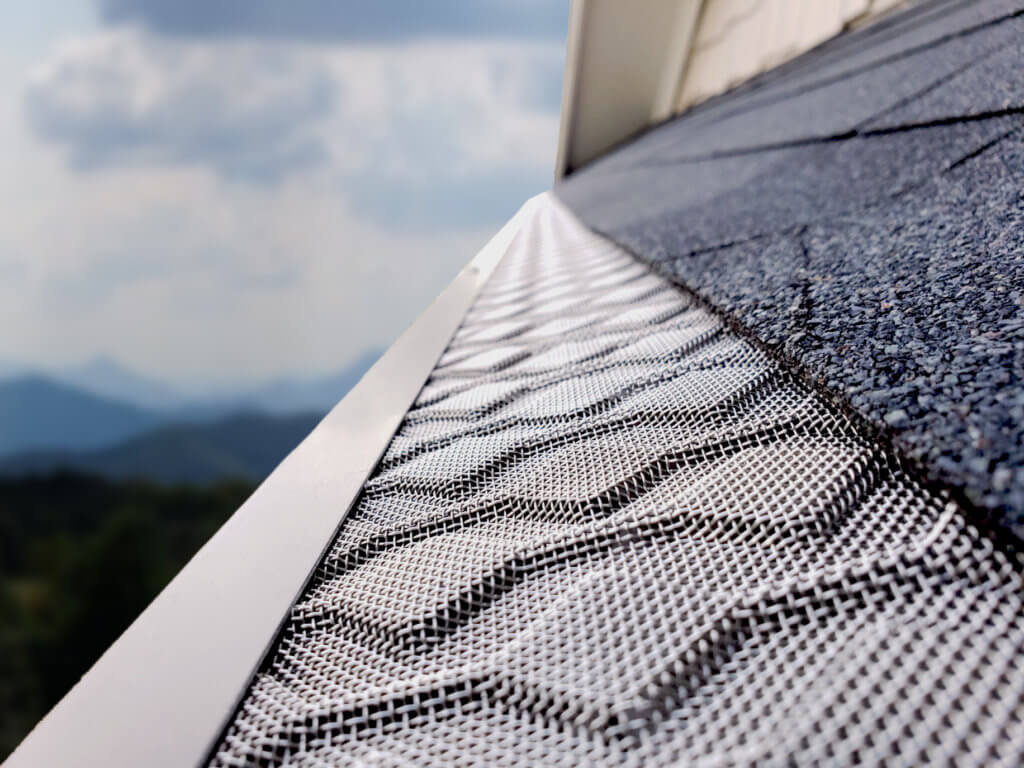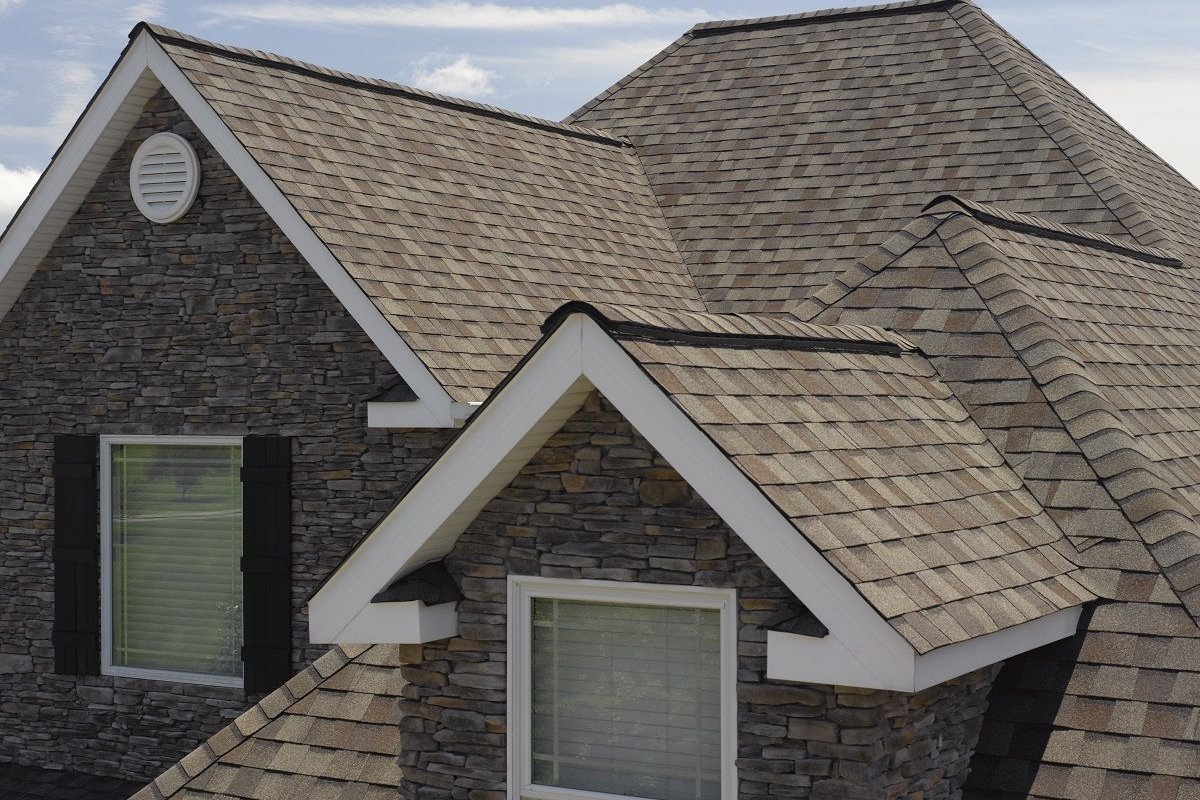OSB vs Plywood for Roof Decking in Scappoose, Oregon: Which is Right?
Choosing the right materials for your home's roof is a critical decision, impacting everything from structural integrity and weather protection to long-term durability and overall cost. While shingles, underlayment, and flashing often get the most attention, the foundation upon which these layers rest – the roof decking, also known as sheathing – is arguably just as important. In Scappoose, Oregon, where homes face varied weather patterns including significant rainfall, selecting a roof decking material that can withstand the local climate is paramount. The two most common materials used for residential roof decking are Oriented Strand Board (OSB) and plywood. Both serve the same fundamental purpose – providing a continuous structural surface to attach roofing materials and helping to brace the roof framing – but they differ significantly in composition, performance, and cost. Understanding these differences is essential for any homeowner planning a new roof or replacement project in the area.
The Vital Role of Roof Decking
Before diving into the specifics of OSB and plywood, it's important to appreciate why roof decking is so vital. The roof deck is a structural component that connects the rafters or trusses, creating a rigid diaphragm that helps the roof system resist wind uplift and seismic forces. It provides the nailing surface for shingles, shakes, tiles, or metal panels. Furthermore, it serves as a base for the underlayment, which is the primary barrier against moisture penetration. A compromised or improperly installed roof deck can lead to a host of problems, including sagging roof lines, fastener pull-out (causing shingles to detach), and water damage to the underlying structure. Given the damp climate often experienced in Scappoose and surrounding areas, the ability of the decking to handle moisture is a significant factor in its long-term performance.
Understanding Oriented Strand Board (OSB)
OSB has become increasingly popular in residential construction over the past few decades, largely due to its cost-effectiveness and availability. It's an engineered wood product manufactured from strands of wood arranged in specific orientations and bonded together with advanced adhesives under heat and pressure.
How OSB is Made
The manufacturing process for OSB begins with cutting logs into strands, typically about 3-4 inches long and less than an inch wide. These strands are then dried and mixed with a waterproof adhesive, often a wax or resin. The coated strands are layered in mats, with the strands in the outer layers oriented along the length of the panel (parallel to the longest dimension) and the strands in the inner layers oriented perpendicular to the outer layers. This cross-orientation gives the board strength and stiffness. The mat is then pressed under high heat and pressure to cure the adhesive and create a solid panel, typically 4x8 feet, 4x9 feet, or larger, and in various thicknesses suitable for roofing (commonly 7/16 inch or 19/32 inch).
Pros of Using OSB for Roof Decking
- Cost: Generally, OSB is more affordable than plywood of comparable thickness. This can lead to significant savings on large roofing projects.
- Consistency: OSB panels tend to be very uniform in size and density, with fewer voids or knots compared to plywood. This can make installation slightly easier and result in less waste.
- Sustainability: OSB can be made from fast-growing, smaller-diameter trees, making it potentially more sustainable than plywood which often requires larger logs.
Cons of Using OSB for Roof Decking
- Moisture Sensitivity: This is arguably the biggest drawback of OSB, particularly in wet climates. While the adhesives used are waterproof, the wood strands themselves can absorb moisture. If OSB gets wet and doesn't dry out quickly, the edges can swell significantly and permanently. This swelling can create unevenness on the roof deck, leading to premature wear or cracking of the roofing material above it, and can also compromise the structural integrity over time.
- Weight: OSB is often heavier than plywood of the same thickness.
- Durability During Installation: OSB's edges are more susceptible to damage during handling and installation, especially when wet. It can also be more prone to damage from foot traffic before the roofing is fully installed.
- Fastener Holding: While adequate when dry, OSB's ability to hold fasteners (like nails or screws) can be slightly reduced if the board becomes wet or the edges swell.
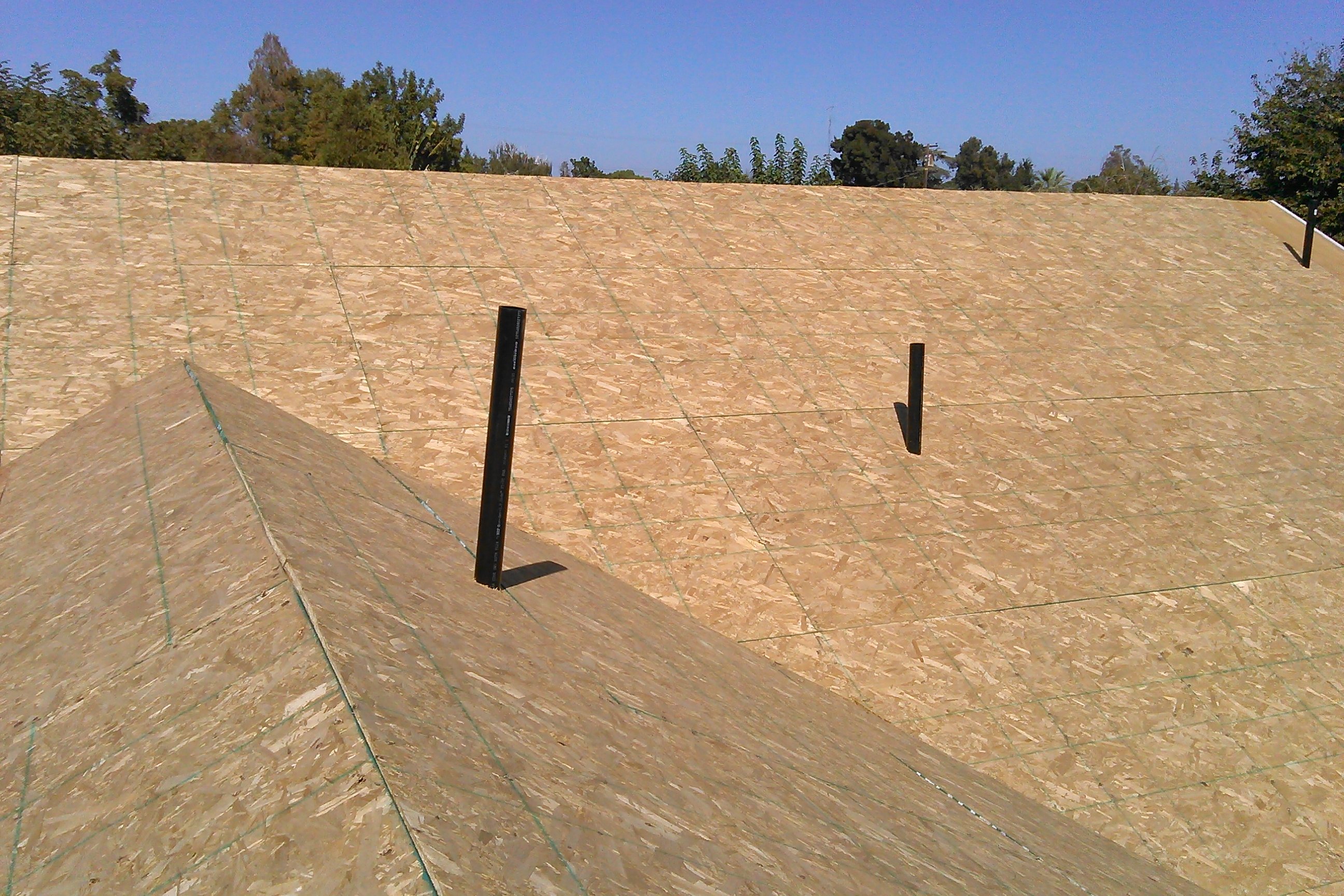
OSB panels installed as roof decking.
Understanding Plywood
Plywood is a traditional and well-regarded building material that has been used for roof decking for a long time. It is also an engineered wood product, but its construction differs significantly from OSB.
How Plywood is Made
Plywood is manufactured by peeling thin layers, or veneers, of wood from logs using a large lathe. These veneers are then dried and graded. Panels are constructed by gluing together multiple layers of veneer, with the grain of each layer oriented perpendicular to the layer below it. This cross-graining technique is key to plywood's strength and stability. The odd number of layers (typically 3, 5, or 7 for standard thicknesses) ensures that the grain on the face and back veneers runs in the same direction, providing balanced strength. Like OSB, the layers are bonded with adhesives under heat and pressure. Roofing plywood is typically rated as CDX grade, meaning the face veneer is C grade (knots and patches allowed), the back veneer is D grade (more defects allowed), and it uses exterior glue (X) suitable for exposure to moisture during construction. Common thicknesses for roofing are 1/2 inch or 5/8 inch, offering comparable strength to 7/16 inch or 19/32 inch OSB, respectively, though actual comparable thickness depends on span rating.
Pros of Using Plywood for Roof Decking
- Moisture Resistance: While not completely impervious to water, plywood is generally more resistant to swelling and permanent damage from moisture exposure than OSB. The cross-grain construction and the nature of the veneers help it retain its shape and structural integrity better when wet, and it tends to dry out more uniformly. This makes it a potentially more resilient choice in damp environments like Scappoose.
- Strength and Stability: Plywood's cross-grain structure gives it excellent two-way strength and dimensional stability. It is less likely to warp or buckle than OSB when exposed to changes in temperature and humidity.
- Durability During Installation: Plywood is typically more robust during handling and installation, with less susceptibility to edge damage and a more solid feel underfoot.
- Fastener Holding: Plywood generally offers superior fastener holding power compared to OSB, which is important for securing roofing materials, especially in areas prone to high winds.
Cons of Using Plywood for Roof Decking
- Cost: Plywood is typically more expensive per sheet than OSB of comparable structural rating. This can increase the overall cost of a roofing project.
- Variability: As a product made from natural veneers, plywood can have more variability in quality, including knots, patches, and potential voids between layers, although CDX grade used for roofing minimizes significant structural voids.
- Weight: Similar to OSB, plywood can be heavy, requiring multiple people to handle large sheets safely.
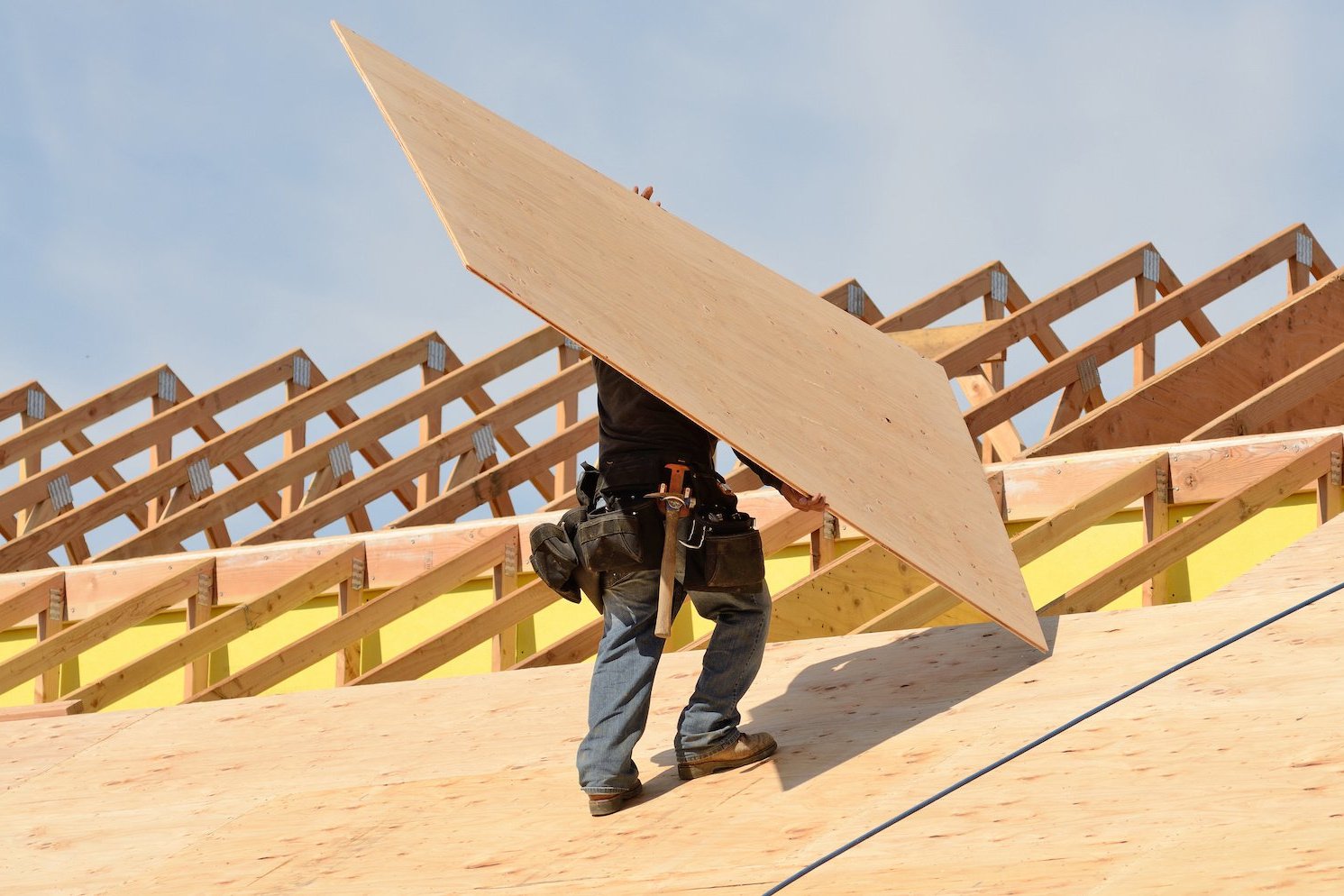
A roofer installing plywood panels as roof decking.
OSB vs Plywood: A Head-to-Head Comparison
Now that we've looked at each material individually, let's compare them directly across several key factors relevant to their use as roof decking, especially considering the climate in places like Scappoose.
Moisture Resistance and Performance
This is perhaps the most critical factor when choosing between OSB and plywood for a region with significant rainfall.
- OSB: OSB's primary weakness is its susceptibility to edge swell when exposed to moisture. While the surface might dry, the edges can absorb water and swell permanently, sometimes by as much as 15-20%. This swelling creates ridges that can telegraph through the roofing material, causing stress, cracking, and premature failure of shingles. If it remains wet for extended periods due to a leak or improper ventilation, the structural integrity can also be compromised.
- Plywood: Plywood is generally more forgiving when it comes to moisture. The cross-banded veneers resist swelling more effectively, and while it can still be damaged by prolonged exposure, it is less prone to the severe, permanent edge swell seen in OSB. It also tends to dry out more evenly.
Conclusion on Moisture: In areas prone to moisture, like Scappoose, plywood holds a distinct advantage due to its greater resilience to water absorption and less tendency for permanent swelling. However, neither material is waterproof, and proper installation with adequate underlayment and ventilation is crucial regardless of which is chosen.
For non-urgent situations, such as planning your roof replacement budget or evaluating costs for future projects, getting an initial understanding of potential expenses is helpful. You can get an instant estimate for your roofing project by visiting: Get your free instant roof estimate
Structural Strength and Span Rating
Both OSB and plywood are designed to meet specific structural requirements for roof decking, primarily related to their ability to span between rafters or trusses without excessive deflection.
- OSB: OSB panels are manufactured with specific span ratings (e.g., 24/16, 32/16). The first number indicates the maximum recommended spacing for roof rafters (in inches), and the second is for floor joists. For roofing, you'd typically look at the first number. A common rating like 24/16 means it can span 24 inches for roof applications. The required thickness depends on the span rating needed for your framing. While strong, OSB can sometimes exhibit slightly more deflection under load compared to plywood of equivalent span rating.
- Plywood: Plywood also comes with span ratings. For a given thickness, plywood often has a slightly higher structural capacity or stiffness compared to OSB. For example, 1/2 inch plywood might have a span rating comparable to 19/32 inch OSB. Plywood's cross-grain construction provides robust strength in both directions.
Conclusion on Strength: Both materials are manufactured to meet building code requirements for structural performance when the correct thickness and span rating are used for the framing. Plywood may offer a marginal advantage in stiffness or strength for a given thickness, but properly rated OSB is structurally sound for its intended use.
Installation Considerations
Installation speed and ease can impact labor costs.
- OSB: OSB is uniform and dimensionally stable when dry, which can make it easy to handle and cut. However, its susceptibility to edge damage and swelling when wet can make it less durable during the construction phase if exposed to rain. Fastening requires careful attention to recommended nail patterns and edge distances to ensure adequate hold, especially near edges.
- Plywood: Plywood is generally more rigid and less prone to edge damage during handling. It provides a solid surface for walking on during installation. Its superior fastener holding means there's less risk of nails or staples pulling out. However, plywood can sometimes be less perfectly uniform than OSB due to natural wood variations, though this is usually minor with standard roofing grades.
Conclusion on Installation: Plywood is generally considered more durable and easier to work with on the job site, particularly in less-than-ideal weather conditions. Its robustness can potentially speed up installation slightly and reduce the risk of material damage before the roof is weather-tight.
Cost Analysis
The cost difference between OSB and plywood is a primary driver for material selection.
- OSB: OSB typically has a lower material cost per sheet than plywood with a comparable span rating. This difference can add up significantly on a large roof, making OSB a more attractive option for budget-conscious projects.
- Plywood: Plywood's material cost is generally higher. While labor costs for installation are similar per sheet, the higher material price makes the overall decking portion of the project more expensive.
Conclusion on Cost: OSB is almost always the less expensive option for the material itself. While installation costs are comparable, the initial material saving is the main reason builders often opt for OSB. However, potential long-term issues related to moisture could theoretically lead to higher costs down the road if the deck fails prematurely.
Environmental Impact
The environmental footprint of building materials is an increasing concern.
- OSB: OSB can be made from smaller, fast-growing tree species, including those from sustainably managed forests. The process uses a high percentage of the log, reducing waste.
- Plywood: Plywood typically requires larger, higher-quality logs for peeling veneers. While sustainable forestry practices apply to both, the resource requirements can differ.
Conclusion on Environment: Both materials can be sourced from sustainable forests. OSB's ability to utilize a wider range of wood species and smaller trees may give it a slight edge in some sustainability metrics.
Building Codes and Standards
Both OSB and plywood used for roof decking must meet specific standards set by organizations like the APA – Engineered Wood Association and comply with local building codes.
- Both: Panels will have stamps indicating their type (OSB or Plywood), grade (e.g., Sheathing, CDX), span rating, and thickness. Ensuring the material meets the required span rating for the framing is critical for structural integrity and code compliance. Building codes in places like Scappoose will specify minimum requirements based on expected snow loads, wind loads, and rafter spacing.
Conclusion on Codes: As long as the correct type, thickness, and span rating are selected based on the structural design and local building codes, both OSB and plywood are acceptable decking materials. The choice then comes down to performance characteristics, cost, and personal preference.
Potential Issues and Long-Term Performance
The long-term performance of your roof deck is heavily influenced by how well it withstands the elements, particularly moisture.
- OSB: The primary long-term issue with OSB is edge swelling caused by moisture. This can lead to ridges under the shingles, accelerating shingle wear and potentially causing leaks. In severe cases of prolonged moisture exposure (e.g., from an undetected leak), OSB can lose significant structural integrity, becoming soft and spongy.
- Plywood: Plywood is more resistant to permanent swelling. While it can delaminate (layers separating) if exposed to significant, prolonged moisture, it generally maintains its structural properties better than OSB under damp conditions. Plywood is less likely to cause the ridging issues associated with OSB edge swell.
Long-Term Implications: While OSB offers initial cost savings, its greater susceptibility to moisture damage, especially edge swell, means that proper installation, effective underlayment, and excellent roof ventilation are absolutely critical for its long-term performance. In a climate like Scappoose, where rain is common, the slightly higher cost of plywood might be seen as an investment in greater resilience and potentially longer deck lifespan, reducing the risk of issues that could shorten the life of the roofing material installed over it.
Installation Best Practices
Regardless of whether you choose OSB or plywood, proper installation is key to maximizing the lifespan and performance of your roof deck and the entire roofing system.
- Proper Spacing: Panels must be installed with a small gap (typically 1/8 inch) between edges and ends to allow for expansion and contraction due to temperature and humidity changes. Failing to do this is a major cause of buckling and ridging, especially with OSB.
- H-Clips: H-clips are small metal connectors inserted between the unsupported edges of adjacent panels (usually halfway between rafters) to provide edge support and ensure panels are properly aligned. They are often required by code for certain thicknesses and span ratings.
- Correct Fasteners: Use the specified type and length of nails or screws for securing the decking to the rafters. Fasteners must penetrate into the framing adequately (typically 3/4 inch). Follow recommended fastening patterns to ensure the deck is securely attached and meets structural requirements.
- Acclimation: Allow the panels to acclimate to the local climate conditions on the job site for a period before installation. This helps minimize movement after installation.
- Protect from Moisture: Store panels off the ground and under cover. Once installed, get the roof dried-in (install underlayment and flashings) as quickly as possible to protect the decking from rain.
If you have visible signs of roof deck issues, such as sagging, soft spots, or significant leaks, these are urgent situations that require professional attention. You can book a direct appointment with pre-vetted roofers to assess the damage and recommend repairs or replacement.
To schedule a professional inspection for urgent roofing issues: Book a roofing appointment
Making the Right Choice for Your Scappoose Home
Choosing between OSB and plywood for your roof deck involves weighing initial cost against long-term performance and resilience, particularly in the context of the Scappoose climate.
- Choose OSB if: Your budget is the primary concern, and you are confident that the roof will be properly installed with excellent underlayment and ventilation to minimize moisture exposure risks. Ensure the specified thickness and span rating meet code for your framing.
- Choose Plywood if: You prioritize maximum durability and resistance to moisture, are willing to accept a higher material cost, and want the added assurance of a material that is less prone to permanent swelling and offers superior fastener holding. Plywood is often the preferred choice by many roofing professionals due to its reliability.
For homeowners in Scappoose, the increased resistance to moisture offered by plywood is a significant factor to consider. While OSB can perform adequately when kept dry, the reality of Pacific Northwest weather means that the deck is likely to encounter some moisture exposure during its lifespan, whether from installation delays, ice dams, or leaks. Plywood's ability to better handle such exposure can contribute to a longer-lasting and more trouble-free roof system. Ultimately, discussing the options with your roofing professional is the best approach, as they can assess your specific roof structure, local conditions, and budget to provide tailored advice.
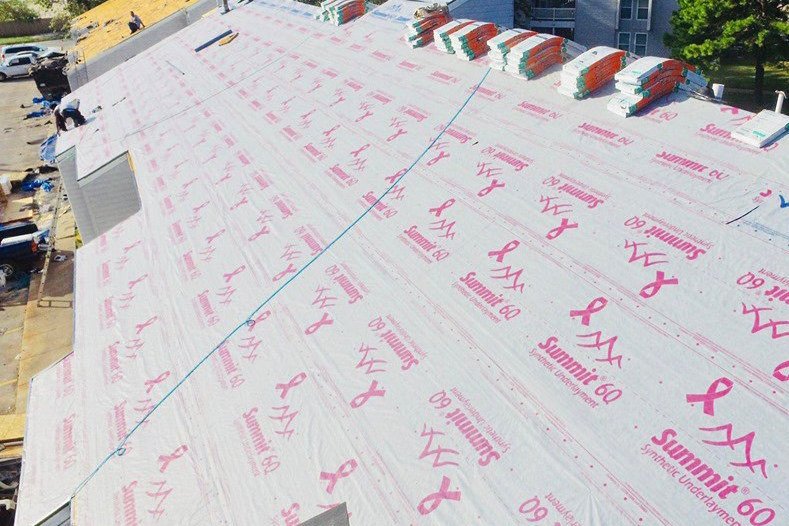
Roof underlayment being installed over the decking provides a crucial layer of moisture protection.
Ensuring Your Roof Deck is Properly Installed
The quality of the roof deck installation is just as important as the material choice itself. Proper fastening, correct spacing, and diligent protection from moisture during the construction phase are non-negotiable. A poorly installed deck, regardless of whether it's OSB or plywood, can compromise the entire roof system. This is why hiring experienced and reputable roofing contractors is essential.
When planning a major roofing project, understanding the costs involved is a key first step. SkyQuote's instant estimate service can give you a preliminary idea of the investment required for your roof replacement or repair based on the size and complexity of your roof, incorporating local pricing data relevant to the Scappoose area. This helps you budget effectively and prepare for discussions with contractors.
To get a quick, initial understanding of the potential cost for your roofing project based on your specific property, utilize our instant estimate tool. It's a great resource for planning and budgeting purposes.
Plan your project with a free estimate: Get your free instant roof estimate
For situations where you suspect your current roof deck might be compromised – perhaps you've noticed soft spots, leaks, or unusual sagging – immediate professional inspection is necessary. These are urgent issues that shouldn't be delayed. SkyQuote's direct appointment booking service connects you with qualified local roofers who can assess the situation promptly and recommend the appropriate course of action, whether it's repair or replacement of the affected decking.
If you have pressing concerns about your roof's condition, especially if you suspect decking damage or have active leaks, it's crucial to get a professional assessment quickly. Use our service to connect with local experts for an appointment.
Address urgent roof issues by booking an appointment: Book a roofing appointment
Understanding the materials that make up your roof, including the decking, empowers you as a homeowner. While the technical details of OSB versus plywood might seem minor, their differences can have significant implications for your roof's performance and longevity, particularly in a climate like Scappoose, Oregon. Investing in quality materials and professional installation ensures that your roof deck provides a solid and reliable foundation for decades to come.
Building a Strong Foundation for Your Roof
The roof deck is the unsung hero of your roofing system. It's the critical layer that provides structural support, a nailing base, and a crucial barrier against the elements when combined with proper underlayment. Whether you ultimately choose OSB or plywood for your home in Scappoose, making an informed decision based on their respective strengths and weaknesses is vital. Consider the climate, your budget, and the recommendations of trusted roofing professionals. A well-chosen and expertly installed roof deck contributes significantly to the overall health, durability, and weather resistance of your entire roof, protecting your home for years to come.
